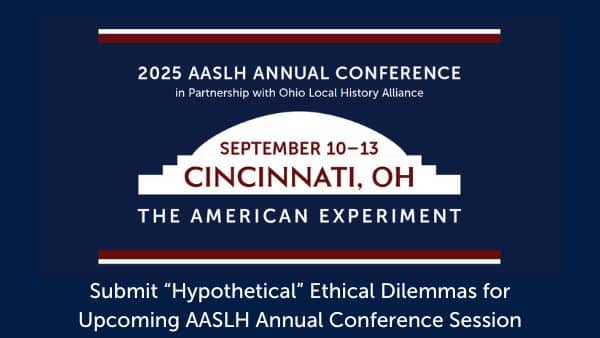Editor’s note: This post is part of a series to highlight AASLH members in the state of Kentucky who are are real-world examples of the 2015 AASLH Annual Meeting Theme: The Power of Possibility.
The American Printing House for the Blind (APH) was founded in 1858 but our corporate museum only opened in 1994. It is one of the most unique places you will ever visit. Somehow, the workers at APH have always been aware of the possibilities in their institutional history and that it was worth saving. Being director of the Museum at APH is like being director of a museum with 300 curators. Across the 279,000 square feet that makes up the Printing House are engaged employees who have squirreled away examples of tactile books and educational aids and the tools we used to manufacture them.
A few years ago, a dealer was allowed to buy an antiquated paper shear from our salvage area, where surplus equipment and office furniture is staged. One of our foremen noticed it was gone, realized that it was an important piece, and recovered the piece for our museum. I loved it! There are still unique rotary presses, former workhorses in our braille printing department, sitting down in that salvage area, each with a cardboard label carefully identifying the maker and date.
Our staff are very loyal, a hallmark of the company throughout its history. If I’m researching the history of a relief puzzle map, and I know that we switched from hard rubber to a plastic material in the 1960s, I could go down to the production floor and ask Ron Gadson. Ron started at APH over 40 years ago. Looking at the back of a puzzle piece, which had me stumped because it looked more like Masonite than either plastic or rubber, he told me they poured a loose binder material into the rubber which caused the end product to end up looking like…Masonite. None of that is written down anywhere in the annual reports, that was not a detail considered important enough to record. When Ron retired, I told him I wanted to stuff him into a file cabinet so that all those little details are saved. And I was only halfway joking.
We are dedicated to make our collections accessible. At a typical museum, well let’s be honest, at a very progressive museum, a person who is visually impaired might be able to explore a bronze bust with a cotton glove while an interpreter describes the piece. At APH, most of our cases are designed to allow a visually impaired visitor to open and “see” the artifacts with their hands. Most of our labels are recorded and available via a sound stick. Our videos are close captioned. Our aisles are designed for comfortable access and labels are low enough for visitors in wheel chairs. That’s very good. Nonetheless, you could have done the same thing thirty years ago and not been breaking much new ground. In the meantime a whole new range of technologies for portable guides and audio description and immersive environments have been developed. So we have some work to do.
I hope you get a chance to visit APH during your visit to Louisville. We are sponsoring a pre-conference workshop on September 16, “Accessibility in the Museum Setting,” and I encourage you to sign up!
Mike Hudson has been the director of the Museum of the American Printing House for the Blind since 2005.




